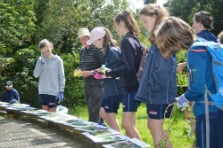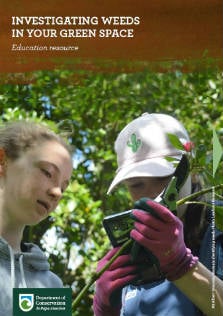This resource is part of the Protecting your environment series, to encourage primary and intermediate students to go outdoors, explore and connect to a local green space.
Published: 2017
Download the resource
Investigating weeds in your green space (PDF, 4,592K)
Factsheets
- Banana passionfruit (PDF, 445K)
- Buddleia (PDF, 525K)
- Climbing asparagus (PDF, 447K)
- Darwin's barberry (PDF, 477K)
- English ivy (PDF, 513K)
- Japanese honeysuckle (PDF, 501K)
- Moth plant (PDF, 451K)
- Old man's beard (PDF, 468K)
- Spartina (PDF, 287K)
- Wandering willie (PDF, 506K)
- Wild ginger (PDF, 525K)
- Wilding conifers (PDF, 504K)
- Woolly nightshade (PDF, 436K)
Learning outcomes

Students identifying weeds
Using this resource students can:
- gather and interpret data about weeds living in a local green space
- identify and learn about introduced weeds and how they affect native plants and animals
- begin to understand how weeds have an impact on the environment and wider ecosystem.
Curriculum links
Level 1-4 Science
- Living World: Planet Earth and Beyond Level 1 and 2: Interacting systems: Describe how natural features are changed and resources affected by natural events and human actions.
- Living World: Ecology Level 3 and 4: Explain how living things are suited to their particular habitat and how they respond to changes, both natural and human-induced.
- Nature of Science: Investigating in science, Communicating in science, Understanding about science, Participating and contributing.
Science capabilities
- Gather and interpret data
- Use evidence
- Critique evidence
- Interpret representations
- Engage with science
English: Listening, Reading and Viewing
Learning sequence
- Getting to know weeds in your green space - Students have outdoor experiences to spark their interest in weeds.
- Planning an investigation - Start or continue a learning inquiry about weeds. Students reflect on knowledge and then ask questions about weeds.
- Gathering and reflecting on data about weeds in your green space - Survey and identify weeds in your green space. Students add to their knowledge, reflect on predictions, and use and critique their evidence/data about weeds.
- Finding out more about weeds and how they change an ecosystem- Students identify how weeds could change local ecosystems.
- Sharing knowledge and taking next steps- Students share their findings with the community and then take the next steps in exploring and enhancing their green spaces.
Learning levels
- Primary
- Secondary
Topics
- Forests and green spaces
- Pests and threats
Curriculum learning areas
- Science
- Social science
- Education for sustainability
- English
- Maths and statistics
Webinars
Webinars are available to view on the Science Learning Hub website. They use the Exploring your local environment resources to model how conservation education can support student inquiry into a local green space:
Special thanks to Science Learning Hub for partnering with us to deliver these fantastic webinars.
Contact
For questions or feedback about these resources, email engagement@doc.govt.nz.
